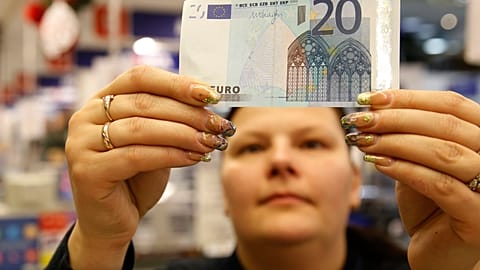Millions of Europeans live in poverty, but the meaning of a comfortable income differs widely across the continent.
More than 72 million people in the EU were classed "at risk of poverty" in 2024, representing 16.2% of the population.
Even so, living on the breadline looks vastly different when comparing poverty thresholds between countries.
The "at-risk-of-poverty rate" is the share of people whose median equivalised disposable income falls below a given threshold. This threshold is set at 60% of the national median income.
However, Eurostat points out that this indicator does not measure wealth or actual poverty.
Rather, it reflects low income compared with others in the same country, which “does not necessarily imply a low standard of living”.
On average in the EU, the annual median equivalised income per person in 2024 was €21,582. 60% of that amount is €12,949, or about €1,079 per month. Anyone with an income below this level is considered at risk of poverty.
However, country-level figures give a much clearer picture. In the EU, this threshold ranges from €391 in Bulgaria to €2,540 in Luxembourg.
When candidate countries with available data and EFTA members are included, it varies from €201 in Turkey to €2,596 in Switzerland. Norway is also among the three countries where the threshold exceeds €2,000.
The at-risk-of-poverty threshold falls between €1,500 and €2,000 in Denmark, Austria, Ireland, the Netherlands, and Belgium, listed from highest to lowest within this group.
This level is below €750 in several countries, including Latvia, Portugal, Croatia, Lithuania, Poland, Greece and Slovakia. It falls below €500 in Hungary, Romania, Bulgaria, Serbia and Turkey.
Among the EU’s ‘Big Four’, Germany has the highest at-risk-of-poverty threshold at €1,381, followed by France (€1,278), Italy (€1,030) and Spain (€965).
For a household of two adults with two children under 14, the at-risk-of-poverty threshold is 2.1 times the single-person threshold. This equals €2,266 in the EU, €423 in Turkey and €5,452 in Switzerland.
What explains the differences?
At-risk-of-poverty thresholds are directly tied to a country’s median equivalised income. Differences in productivity and industrial structure help explain why these levels vary so much, said Giulia De Lazzari, an economist at the International Labour Organization (ILO). Higher productivity allows countries to sustain higher wages.
As a result, nations with large high-value sectors — such as finance, information technology or advanced manufacturing — tend to pay more. This also means their at-risk-of-poverty thresholds are higher.
How do poverty thresholds compare in PPS?
The gap becomes narrower when measured in purchasing power standards (PPS), but the differences remain clear. PPS is an artificial currency unit designed so that one PPS can, in theory, buy the same amount of goods and services in every country.
In PPS terms, for a single adult, the at-risk-of-poverty thresholds range from 449 in Serbia to 1,889 in Luxembourg.
Turkey, Hungary, Slovakia, and Greece are among the lowest five. On the higher end, Norway, Switzerland, Austria, and the Netherlands are among the top five.
Among the major economies, the threshold is highest in Germany. France follows, with Spain and Italy both at 1,060.
Where is the risk of poverty highest?
According to Eurostat, 16.2% of the EU population was at risk of poverty in 2024. The rate ranges from 9.5% in Czechia to 22.2% in Turkey and North Macedonia.
EU candidate countries, as well as Balkan and Eastern European nations, have higher rates of people at risk of poverty. Among the major economies, the rate is also high in Spain (19.7%) and Italy (18.9%), while France (15.9%) and Germany (15.5%) are slightly below the EU average.


















